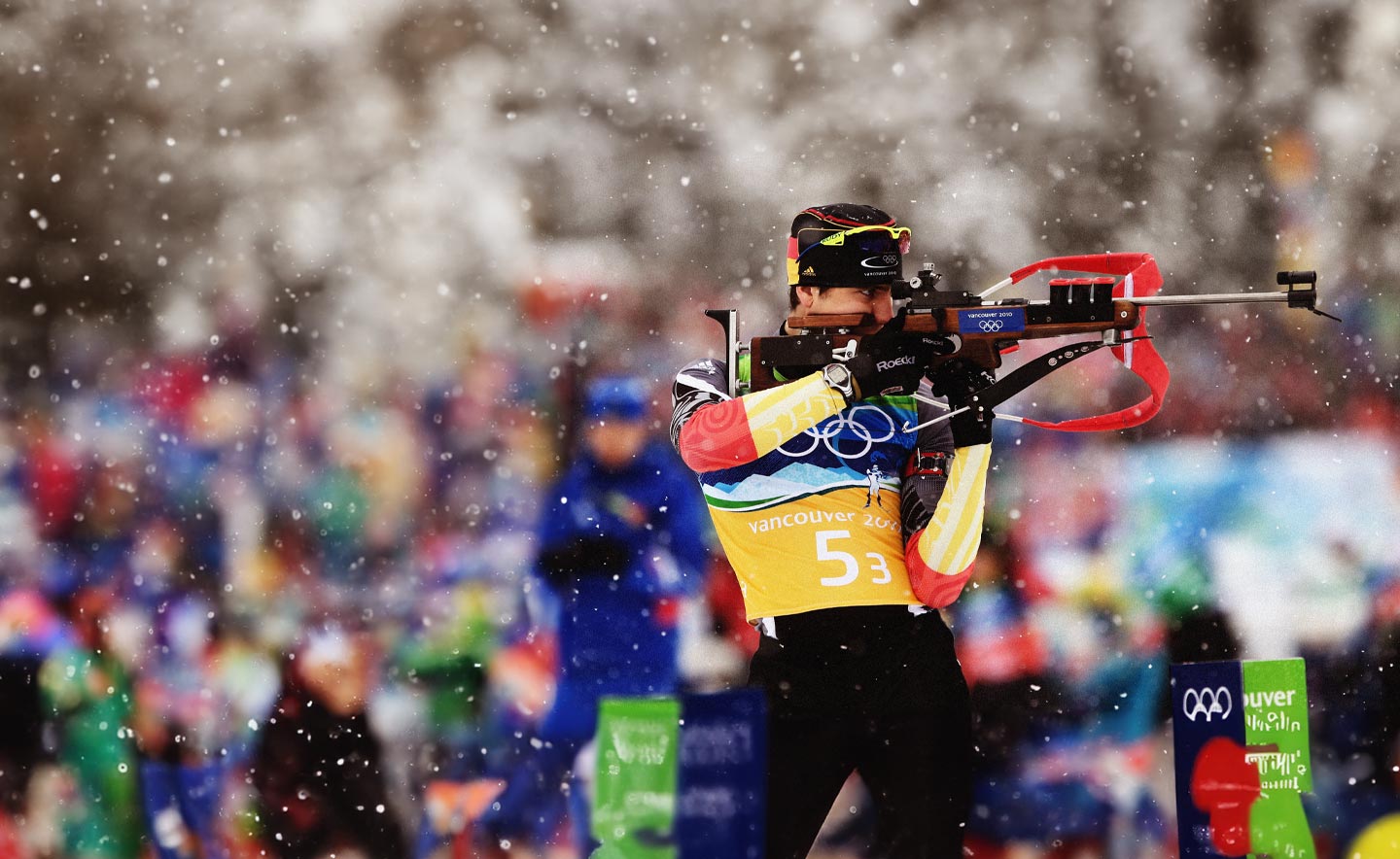
Biathlon
The biathlon originated in Scandinavia in the 18th century and the first official competition probably dates back to 1912. As we look forward to Milano Cortina 2026, let’s learn all about this sport.
Competitions
Biathlon is a winter discipline that includes two events: rifle shooting and cross-country skiing. Cross-country skiing races in freestyle technique take place on a track that is covered multiple times, depending on the length of the race. Each lap, athletes undergo a shooting test — one standing, one in the prone position — firing 5 shots (the number of attempts changes according to the speciality). The targets have variable diameters (45 mm for shooting in the prone position, 115 mm for standing), placed 50 m from the firing line. A missed target results in a penalty: an extra 150 m to ski (a penalty loop) or 1 minute added to the overall time (in individual races).
The competitions at Milano Cortina 2026 will consist of 11 events:
Men
- 10 km sprint
- 20 km individual
- 12.5 km pursuit
- 15 km mass start
- 4 x 7.5 km relay
Women
- 7.5 km sprint
- 15 km individual
- 10 km pursuit
- 12.5 km mass start
- 4 x 6 km relay
Mixed
- 4 x 6 km mixed relay
The men's and women's races will take place in Anterselva/Antholz, an international biathlon centre in the utonomous Province of Bolzano.
Olympic History
Military patrols are the direct precursor of biathlon. The event was an integral part of the first Winter Olympic Games in Chamonix in 1924. At the time, the race involved teams of four men, necessarily consisting of an officer, a non-commissioned officer, and two soldiers. At the Olympics at St. Moritz in 1928, Garmisch-Partenkirchen in 1936, and St. Moritz in 1948, the military patrol appeared as a demonstration sport (the 1936 Games in Garmisch-Partenkirchen saw Italy's only success).
Biathlon has been part of the Olympic programme since the Games in Squaw Valley in 1960. Women's competitions were regulated in 1980 and have been included in the Olympic programme since 1992. The Scandinavian countries have stood out most in this sport. It is the only skiing sport regulated worldwide by the IBU (International Biathlon Union); in Italy, it falls under the FISI (Italian Winter Sports Federation).
Basic Rules
In the sprint races, female competitors cover distances of 7.5 km and the men cover 10 km. They stop twice and must hit five targets with five bullets each time.
In the pursuit, athletes start the race sequentially based on their finishing time (or rather their delay behind the winner) in the sprint competition. Competitors stop four times and must hit all five targets with five bullets each time.
In the individual races, women cover 15 km and men cover 20 km. Athletes stop four times at the shooting range and must hit all five targets with five bullets each time. For each missed target in this event, the athlete incurs a one-minute penalty (instead of the penalty loop).
The relay is a team speed event where four athletes each tackle a section of track: 7.5 km each for a total of 30 km for men and 6 km each for a total of 24 km for women. It begins with a mass start with the first skiers from each team. Each team member has two shooting sequences and three extra bullets (for a total of eight) to hit the five targets required for each shooting phase. The three extra bullets can be loaded one at a time.
In the mixed 4x6 km relay, there are 20 teams, each composed of four athletes — two women and two men — who each ski 6 km. The event starts with the first skier from each team. Each team member has two shooting sequences: one in the prone position and one standing. In each shooting sequence, competitors are required to hit five targets and are given three extra bullets (for a total of eight).
In the mass start, 30 athletes start simultaneously. Women compete over 12.5 km and men over 15 km. They stop a total of four times at the shooting range where they must hit five targets with five bullets each.
Curiosities about Italian Champions
Italy has never won a gold in biathlon at the Olympics, but it has still claimed seven medals. The first Italian medal was won by Johann Passler, who took bronze in the individual event at Calgary in 1988. There, Passler also won a second bronze medal in the 4x7.5 km relay with his teammates Werner Kiem, Gottlieb Taschler, and Andreas Zingerle. In Nagano in 1998, Pieralberto Carrara from Serina, Bergamo, won silver in the 20 km. Sixteen years later, at Sochi in 2014, Dorothea Wierer, Karin Oberhofer, Dominik Windisch, and Lukas Hofer finished third behind Norway and the Czech Republic in the debut mixed relay.
Italy won two medals at Pyeongchang in 2018. Dominik Windisch won bronze in the sprint, and Arnd Peiffer, Lisa Vittozzi, Dorothea Wierer, and Lukas Hofer won bronze in the mixed relay. In Beijing in 2022, Dorothea Wierer made history by winning a bronze medal in the individual sprint event at the Olympic Games.
FAQ
Here are the answers to your questions.
Which male biathlete has won the most medals at the Olympics?
Which female biathlete has won the most medals at the Olympics?
Which nations have won the most medals at the Olympic Games?
Where does the word biathlon come from?
Where will the biathlon competitions at Milano Cortina 2026 take place?
Discover the Other Sports
History, curiosities and the rules of all the other Olympic disciplines planned for Milano Cortina 2026
































































































